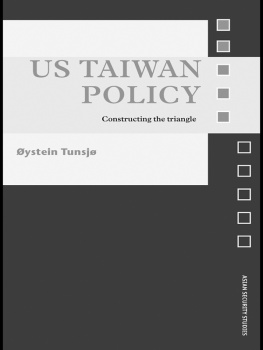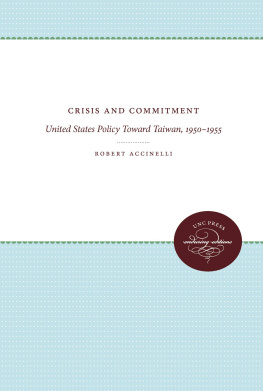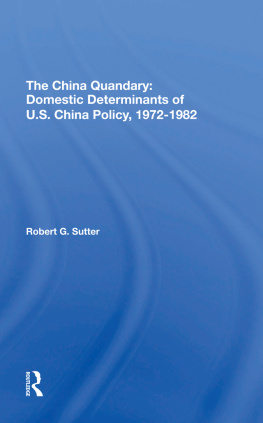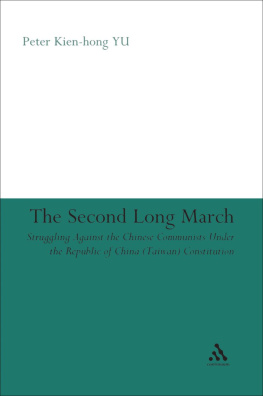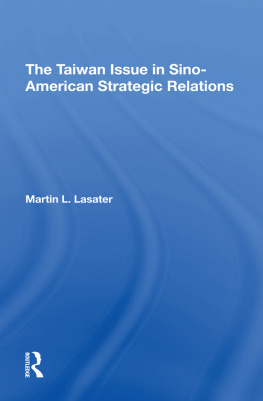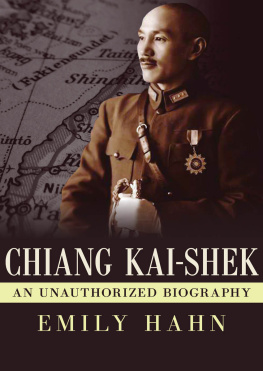WASHINGTONS TAIWAN
DILEMMA

 19491950
19491950
FROM ABANDONMENT TO SALVATION
DAVID M. FINKELSTEIN
NAVAL INSTITUTE PRESS
ANNAPOLIS, MARYLAND
This book has been brought to publication with the generous assistance of Marguerite and Gerry Lenfest.
Naval Institute Press
291 Wood Road
Annapolis, MD 21402
1993 by David M. Finkelstein
All rights reserved. No part of this book may be reproduced or utilized in any form or by any means, electronic or mechanical, including photocopying and recording, or by any information storage and retrieval system, without permission in writing from the publisher.
First Naval Institute Press paperback edition published in 2014.
ISBN: 978-1-61251-474-1 (eBook)
The Library of Congress has cataloged the hardcover edition as follows:
Finkelstein, David Michael.
From abandonment to salvation : Washingtons Taiwan dilemma, 19491950 /
David M. Finkelstein
p. cm.
Includes bibliographical references.
1. United StatesForeign relationsTaiwan. 2. TaiwanForeign relations United States. 3. TaiwanHistory1945 4. United StatesForeign relations19451953. 5. United StatesForeign relationsChina. 6. China Foreign relationsUnited States. I. Title.
#183.8.T3F56 1993
327.73051249dc20
93-3784 CIP

 Print editions meet the requirements of ANSI/NISO z39.48-1992 (Permanence of Paper).
Print editions meet the requirements of ANSI/NISO z39.48-1992 (Permanence of Paper).
22 21 20 19 18 17 16 15 14 9 8 7 6 5 4 3 2 1
First printing
For my daughters, Allison and Elaina
I am deeply indebted to many persons and institutions over the years that made this study possible.
The faculties and staffs of the department of history and the department of East Asian studies made my time as a Princeton graduate student exciting and challenging. I am forever grateful to Professor Marius Jansen and Professor Frederick Fritz Mote for taking me under their wings. When I showed up at Old Nassau I was still shaking off the mud from a year-long assignment with an infantry battalion in Panmunjom, Korea. I cannot help but think that their decision to have mercy upon that young, rough-edged regular Army captain was the result of their own service in the Pacific Theater of Operations during the Second World War. I can never adequately thank them.
The department of history at the United States Military Academy at West Point provided funds for an important research trip to the Truman Library. Archivists at Princetons Seeley G. Mudd Manuscript Library, the Harry S. Truman Presidential Library in Independence, Missouri, and the MacArthur Memorial in Norfolk, Virginia, all provided invaluable assistance in locating and making available hundreds of documents.
Finally, I wish to heartily thank the Naval Institute Press for the decision to republish this study, making it available to readers once again. Susan Todd Brook and the rest of the crew in Annapolis were terrific to work with.
TABLE OF CONTENTS
The renewal of civil war in 1945 between the Chinese communists and the Nationalist government signaled the demise of Washingtons wartime hopes that U.S. postwar policy in Asia could be anchored upon a stable China allied to the United States. The establishment of the Peoples Republic of China under the Chinese Communist Party in October 1949, and the Nationalist governments retreat to Formosa (now known as Taiwan), left American foreign policy officials and military planners with two significant and interrelated dilemmas: how to deal with the new government on the mainland and what to do about Chiang Kai-sheks holdout regime on the island of Taiwan.
Between autumn 1949 and late spring 1950, set against the larger context of the unfolding Cold War with the Soviet Union, the Truman administrations need to make fundamental decisions on these two policy issues became increasingly pressing. In spite of Pekings outward signs of hostility towards the United States, Mao Tse-tungs homegrown brand of Chinese nationalism raised hopes in some quarters of the U.S. government, particularly in the State Department, that the newly founded Peoples Republic of China might go the way of Yugoslavia under Marshall Tito. What should be done about China? Was it possible that a China under communist rule could be kept out of the Soviet camp? What policies could the United States craft to increase the chances?
Also during this period, it was apparent that the Nationalist government on Taiwan was extremely vulnerable; many feared it would either fall to an invasion or collapse under the weight of its own monumental internal problems. As early as summer 1949 Mao was already instructing his military commanders to prepare plans for the islands capture. Despite the geographic advantages the government on Taiwan enjoyed for its own defense, and despite the enormous operational difficulties an invasion would pose to the mainland armies, many informed U.S. officials believed that in the absence of direct American military intervention, the island would fall quickly. This, they assessed, was the result of a legacy of poor governance since V-J Day, widespread corruption and incompetence within the Nationalist political and military establishments, and popular resentment against the regime. Politically, could the United States afford to lose Taiwan after the loss of the mainland? Strategically, what military value to the United States did the island represent? Was the United States willing to commit forces to save Taiwan? Could the island be wrested from Peking without direct U.S. military intervention? If Taiwan could be secured, what price would Washington pay in terms of strategic equities with the new communist regime on the mainland? How U.S. officials grappled with these questions is the grist of the narrative herein.
This book examines the dilemmas of making China policy in 1949 and 1950. The emphasis, however, is on how the Truman administration approached the question of Taiwan in particular. The story is intriguing, for as the reader will see, the historical evidence clearly suggests that right up until the North Korean invasion in June 1950 the Truman administration remained divided on whether Taiwan was worth saving at all.
This is a study that began as a paper for a graduate history seminar at Princeton University in 1982 and 1983, which in turn grew into a doctoral dissertation (1990) and then transformed into a book originally published by George Mason University in 1993. Like many works of history, this book was a child of its time.
The early 1980s, when this research began, was an exciting time for historians of U.S.-Asian relations in general and of U.S. policy toward China in particular. The formal normalization of relations between the United States and China had just taken place in 1979. Nearly concurrently, beginning in the late 1970s and early 1980s, the U.S. government declassification process was methodically placing into the public domain previously classified materials pertinent to U.S. policy toward China at the close of the 1940s and early1950s. Among the many important resources that became widely available to researchers were new volumes of the State Departments Foreign Relations of the United States series for
Next page

